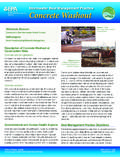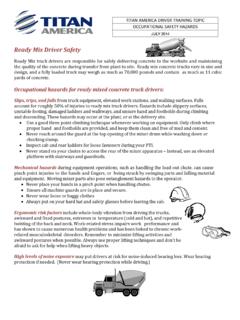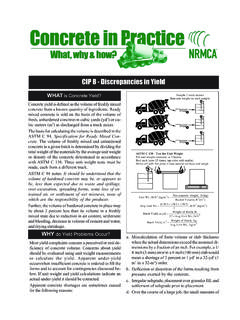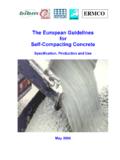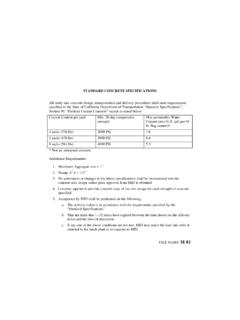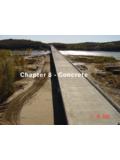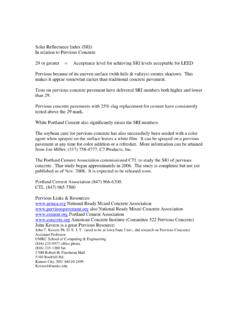Transcription of Material Safety Data Sheet - Buffalo Trail Public Schools ...
1 MSDS: Lafarge ready Mix concrete Page 1 of 6 Revised: 03/01/11 Material Safety data Sheet Section 1: PRODUCT AND COMPANY INFORMATION Product Name(s): Lafarge ready Mix concrete ( concrete ) Product Identifiers: ready Mix concrete , concrete ready Mix, Portland Cement concrete , ready Mix Stucco, ready Mix Grout, ready Mix, concrete , Freshly mixed concrete , Colloidal concrete , Permeable concrete , Shotcrete, Gunite, Polymer-Portland Cement concrete , Colored concrete , Flowable Fill, Roller-Compacted concrete , Fiber Reinforced concrete , Weathermix, UltraCurbTM, UltraDriveTM, UltraFlo-FilTM, UltraHorizontalTM, UltraFootingTM, UltraPatioTM, UltraStampTM, UltraTiltTM, UltraVerticalTM, AgrifargeTM Plus, AgrifargeTM RP, AgrifargeTM 20, 25, 30, 32, ArteviaColorTM, ChronoliaTM, ExtensiaTM, Agilia Screed C.
2 Manufacturer: Information Telephone Number: Lafarge North America Inc. 703-480-3600 (9am to 5pm EST) 12018 Sunrise Valley Drive, Suite 500 Emergency Telephone Number: Reston, VA 20191 1-800-451-8346 (3E Hotline) Product Use: concrete is widely used as a structural component in construction applications. Note: This MSDS covers many types of concrete . Individual composition of hazardous constituents will vary between types of concrete . Section 2: COMPOSITION/INFORMATION ON INGREDIENTS Component Percent (By Weight) CAS NumberOSHA PEL -TWA (mg/m3) ACGIH TLV- TWA (mg/m3) LD50 (mouse) LC50 Crystalline Silica 0-90 14808-60-7 [(10) / (%SiO2+2)] (R); [(30) / (%SiO2+2)] (T) (R) NA NA Calcium Carbonate* 25-65 1317-65-3 15 (T); 5 (R) 3 (R); 10 (T) NA NA Portland Cement* 10-30 65997-15-1 15 (T); 5 (R) 1 (R) NA NA Calcium Hydroxide 15-25 1305-62-0 15 (T); 5 (R) 5 (T) 7300 mg/kg (oral) NA Fly Ash 0-20 68131-74-8 NA NA NA NA Calcium Oxide 0-5 1305-78-8 5 (T) 2 (T) 3059 mg/kg (intraperitoneal) NA Magnesium Oxide 0-4 1309-48-4 15 (T) 10 (I) NA NA Calcium Sulfate* 0-2 13397-24-5 15 (T); 5 (R) 10 (I) NA NA Particulate Not Otherwise Regulated - NA 15 (T); 5 (R) 10 (T).
3 3 (R) NA NA Note: Exposure limits for components noted with an * contain no asbestos and <1% crystalline silica concrete contains cement which is manufactured from materials mined from the earth and is processed using energy provided by fuels. Trace amounts of chemicals may be detected during chemical analysis such as: potassium and sodium sulfate compounds, chromium compounds, nickel compounds, and other trace compounds. Section 3: HAZARD IDENTIFICATION WARNING Corrosive - Causes severe burns. Toxic - Harmful by inhalation. (Contains crystalline silica) Use proper engineering controls, work practices, and personal protective equipment to prevent exposure to wet or dry product. Read MSDS for details. Respiratory Protection Eye ProtectionWaterproof Waterproof Boots Gloves MSDS: Lafarge ready Mix concrete Page 2 of 6 Revised: 03/01/11 Section 3: HAZARD IDENTIFICATION (continued) Emergency Overview: Unhardened concrete is an odorless semi-fluid, flowable, granular paste of varying color and texture.
4 It is not combustible or explosive. Exposure of sufficient duration to wet concrete can cause serious, potentially irreversible tissue (skin, eye, respiratory tract) damage due to chemical (caustic) burns, including third degree burns. Potential Health Effects: Eye Contact (acute): concrete may cause immediate or delayed irritation or inflammation. Eye contact with wet concrete can cause moderate eye irritation, chemical burns and blindness. Eye exposures require immediate first aid and medical attention to prevent significant damage to the eye. Skin Contact (acute): concrete may cause dry skin, discomfort, irritation, severe burns, and dermatitis. Burns: Exposure of sufficient duration to wet concrete can cause serious, potentially irreversible damage to skin, eye, respiratory and digestive tracts due to chemical (caustic) burns, including third degree burns.
5 A skin exposure may be hazardous even if there is no pain or discomfort. Dermatitis: Unhardened concrete is capable of causing dermatitis by irritation and allergy. Skin affected by dermatitis may include symptoms such as, redness, itching, rash, scaling, and cracking. Irritant dermatitis is caused by the physical properties of concrete including alkalinity and abrasion. Sensitization: Allergic contact dermatitis is caused by sensitization to hexavalent chromium (chromate) present in concrete . The reaction can range from a mild rash to severe skin ulcers. Persons already sensitized may react to the first contact with wet concrete . Others may develop allergic dermatitis after years of repeated contact with wet concrete .
6 Inhalation (acute): Breathing dust may cause nose, throat lung or mucous membrane irritation, including choking, depending on the degree of exposure. Inhalation of high levels of dust can cause chemical burns to the nose, throat and lungs. Inhalation (chronic): Risk of injury depends on duration and level of exposure. Silicosis: This product contains crystalline silica. Prolonged or repeated inhalation of respirable crystalline silica from this product can cause silicosis, a seriously disabling and fatal lung disease. See Note to Physicians in Section 4 for further information. Carcinogenicity: concrete is not listed as a carcinogen by IARC or NTP; however, concrete contains trace amounts of crystalline silica and hexavalent chromium which are classified by IARC and NTP as known human carcinogens.
7 Autoimmune Some studies show that exposure to respirable crystalline silica (without silicosis) or Disease: that the disease silicosis may be associated with the increased incidence of several autoimmune disorders such as scleroderma (thickening of the skin), systemic lupus erythematosus, rheumatoid arthritis and diseases affecting the kidneys. Tuberculosis: Silicosis increases the risk of tuberculosis. Renal Disease: Some studies show an increased incidence of chronic kidney disease and end-stage renal disease in workers exposed to respirable crystalline silica. MSDS: Lafarge ready Mix concrete Page 3 of 6 Revised: 03/01/11 Section 3: HAZARD IDENTIFICATION (continued) Ingestion: Do not ingest concrete .
8 Although ingestion of small quantities of concrete is not known to be harmful, large quantities can cause chemical burns in the mouth, throat, stomach, and digestive tract. Medical Conditions Individuals with lung disease ( bronchitis, emphysema, COPD, pulmonary Aggravated by Exposure: disease) or sensitivity to hexavalent chromium can be aggravated by exposure. Section 4: FIRST AID MEASURES Eye Contact: Rinse eyes thoroughly with water for at least 15 minutes, including under lids, to remove all particles. Seek medical attention for abrasions and burns. Skin Contact: Wash with cool water and a pH neutral soap or a mild skin detergent. Seek medical attention for rash, burns, irritation, dermatitis, and prolonged unprotected exposures to wet concrete .
9 Inhalation: Move person to fresh air. Seek medical attention for discomfort or if coughing or other symptoms do not subside. Ingestion: Do not induce vomiting. If conscious, have person drink plenty of water. Seek medical attention or contact poison control center immediately. Note to Physician: The three types of silicosis include: Simple chronic silicosis which results from long-term exposure (more than 20 years) to low amounts of respirable crystalline silica. Nodules of chronic inflammation and scarring provoked by the respirable crystalline silica form in the lungs and chest lymph nodes. This disease may feature breathlessness and may resemble chronic obstructive pulmonary disease (COPD).
10 Accelerated silicosis occurs after exposure to larger amounts of respirable crystalline silica over a shorter period of time (5-15 years). Inflammation, scarring, and symptoms progress faster in accelerated silicosis than in simple silicosis. Acute silicosis results from short-term exposure to very large amounts of respirable crystalline silica. The lungs become very inflamed and may fill with fluid, causing severe shortness of breath and low blood oxygen levels. Progressive massive fibrosis may occur in simple or accelerated silicosis, but is more common in the accelerated form. Progressive massive fibrosis results from severe scarring and leads to the destruction of normal lung structures.

